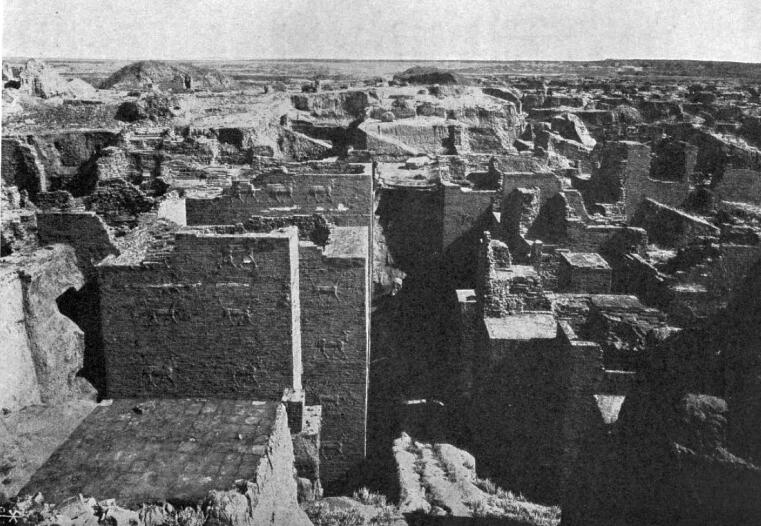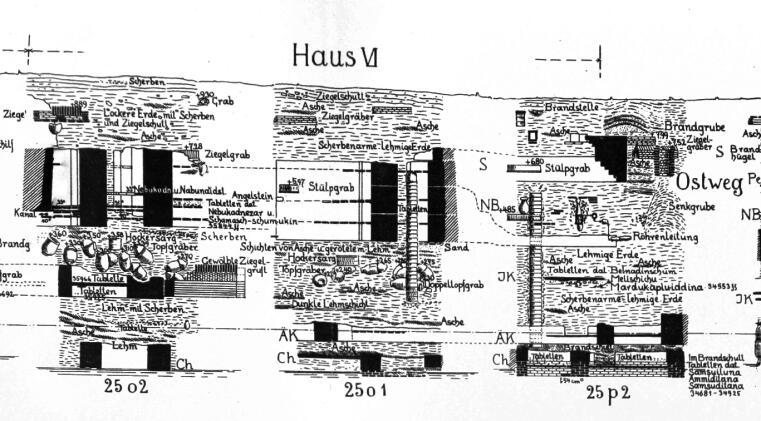Archaeology
by Georg Neumann
Since the excavations in Babylon started more than 120 years ago, the archaeological methodology used in the project to reconstruct the archaeological context of the Neo-Babylonian cuneiform archives must be adjusted to the preserved excavation documentary.
This documentary consists of two excavation journals, recording not only the progress of excavation, but also the weather, water levels, visitors, paydays, and preliminary results. Sometimes there are also small sketches to be found. These entries are supplemented by short reports published in the “Mitteilungen der Deutschen Orient-Gesellschaft” (MDOG), which appeared every 1-2 months.
There are also find journals, photo inventories, maps, plans, and section drawings. All of the documentation is hosted today at four different archives: the Archive of the Deutsche Orient-Gesellschaft, the Central Archive of the Staatliche Museen in Berlin, and the Archive and Photo Archive of the Vorderasiatisches Museum (Berlin).

Not every excavation area is very well documented. This is due to the constant development of excavation and documenting techniques throughout the years (1899-1917). Looking at the final reports published in 10 volumes in the series „Wissenschaftliche Veröffentlichungen der Deutschen Orient-Gesellschaft“ (WVDOG) it becomes obvious that some information must be derived from private notes or field journals of the respective authors. These journals are missing, but may still be found in the estates of the excavators and their assistants (like G. Buddensieg, O. Reuther, F. Wetzel etc.).
To analyze the archaeological context and to re-contextualize the cuneiform archives, every data source will be used because R. Koldewey’s methodology is based on architectural research. His aim was the reconstruction of the architectural structure of the ancient city of Babylon, not the analysis and interpretation of objects. Therefore, the architecture – mostly dating to Neo-Babylonian times – is – even from a modern point of view –published quite well, but the other findings and their archaeological context, like e.g. room inventories, are often missing. In the course of re-interpreting the archival contexts, all objects associated with the cuneiform tablets will be (re-)evaluated and – if possible - embedded into the stratigraphy of the relevant buildings. Special focus lays on the archaeological analysis of the pottery to establish a more detailed chronological framework. The pottery processing is carried out by Ch. Kainert.
To fix the position of the objects and installations, the section drawings and plana of the excavation are used. By looking at the section drawings it is obvious that their aim was to include as much information as possible. Therefore, the section drawings themselves are to be seen as X-ray images of the excavated area, rather than as the drawing of a “cut” at a specific position in the trench. This data source must be handled with caution, but it also bears a lot of information. Unfortunately, not every area was documented by section drawing.

All data and results will be connected to the edited texts, their content and dating to support the reconstruction of the social, economic, and political life in the first Millennium BCE in Babylon.
Further reading:
O. Pedersén, Archive und Bibliotheken in Babylon. Die Tontafeln der Grabung Robert Koldeweys 1899-1917. Abhandlungen der Deutschen Orient-Gesellschaft 25, Saarbrücken, 2005.
K. Sternitzke, Der Kontext der altbabylonischen Archive in Babylon. Mitteilungen der Deutschen Orient-Gesellschaft 148 (2016) 179-197.
